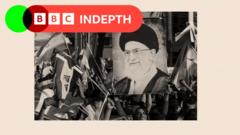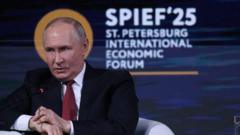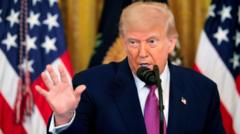**Defense Secretary Pete Hegseth expresses optimism about achieving a consensus on spending targets at an upcoming summit.**
**NATO's Defense Budget Conundrum: Allies Divided on Trump's Demands**

**NATO's Defense Budget Conundrum: Allies Divided on Trump's Demands**
**Tensions rise as NATO members grapple with increased military spending amid Russian threats.**
The NATO alliance finds itself at a crucial juncture as member states wrestle with the contentious issue of defense spending. During a meeting in Brussels, U.S. Defense Secretary Pete Hegseth remarked on a significant divide among allies regarding an increase in military budgets to 5 percent of their national income, a target set forth by President Trump. Although various defense officials cited numerous priorities, including responses to Russian aggression, an agreement on this demand remains tentative as NATO's 32 leaders prepare for their upcoming summit in The Hague later this month.
Hegseth claimed there was "almost near consensus" on the necessity to elevate military expenditure from the current benchmark of 2 percent to 5 percent, stressing the urgency posed by evolving global threats. His assertion reflects ongoing tensions within NATO, particularly given Trump’s warning that American support for European defense could wane if European nations fail to contribute adequately.
Currently, the U.S. allocates about 3.4 percent of its GDP to defense, far surpassing what smaller NATO countries spend. Under Trump’s proposed budget for the fiscal year commencing in October, the U.S. defense spending aims to reach $1.01 trillion, but estimates suggest an additional $200 billion would be needed for the country to meet the 5 percent guideline. As discussions advance, officials remain focused on balancing military readiness against national spending priorities, making it clear that the future of NATO's collective defense strategy hinges on the decisions made in The Hague.
Hegseth claimed there was "almost near consensus" on the necessity to elevate military expenditure from the current benchmark of 2 percent to 5 percent, stressing the urgency posed by evolving global threats. His assertion reflects ongoing tensions within NATO, particularly given Trump’s warning that American support for European defense could wane if European nations fail to contribute adequately.
Currently, the U.S. allocates about 3.4 percent of its GDP to defense, far surpassing what smaller NATO countries spend. Under Trump’s proposed budget for the fiscal year commencing in October, the U.S. defense spending aims to reach $1.01 trillion, but estimates suggest an additional $200 billion would be needed for the country to meet the 5 percent guideline. As discussions advance, officials remain focused on balancing military readiness against national spending priorities, making it clear that the future of NATO's collective defense strategy hinges on the decisions made in The Hague.























